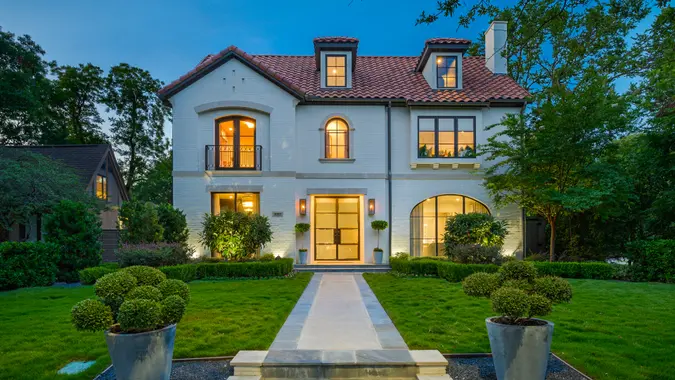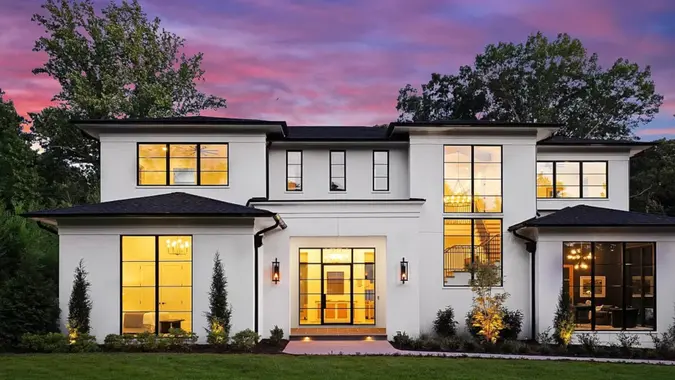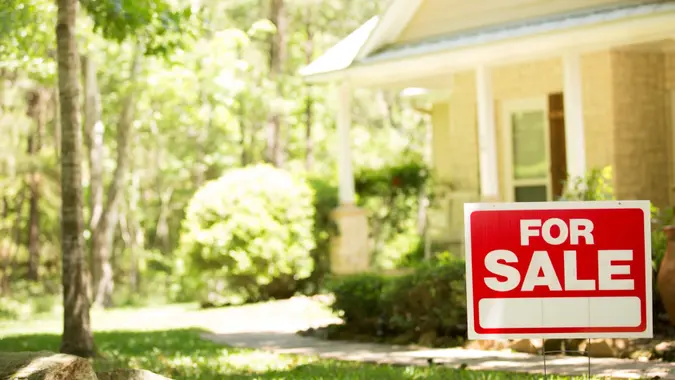Beginner’s Guide To Flipping A House

Commitment to Our Readers
GOBankingRates' editorial team is committed to bringing you unbiased reviews and information. We use data-driven methodologies to evaluate financial products and services - our reviews and ratings are not influenced by advertisers. You can read more about our editorial guidelines and our products and services review methodology.

20 Years
Helping You Live Richer

Reviewed
by Experts

Trusted by
Millions of Readers
TV has a way of making things look exciting and easy to accomplish. This is probably seen most often when it comes to house flipping. House flippers buy beat-up properties on the cheap, pour some money into them to upgrade and make them look beautiful, then quickly pocket a tidy profit. On TV, at least, the house flippers go in and turn the place into a dream home in what seems like no time at all.
See: 3 Things You Must Do When Your Savings Reach $50,000
Unfortunately, the reality of flipping houses isn’t quite as charming. It can be exciting and fulfilling, but it takes more time and work than you see in an hour-long TV show. While the profit potential can be high, there are many risks, the foremost being that you could end up losing quite a bit of money in the process.
Here’s a look at what you’ll need to know about house flipping so that you can determine if you have what it takes to enter this risky but potentially lucrative field.
Researching the Real Estate Market
You shouldn’t enter into any financial transaction without first doing your research. Here are the things you’ll need to look at if you want to become a house flipper.
Understanding Local Market Trends
As any real estate professional will tell you, property valuation is a local phenomenon. While national market trends may play a role, you’ll need to understand how property values move on a local basis to determine if a flip is a good idea. In addition to analyzing property trends on a neighborhood-by-neighborhood basis, you’ll want to identify up-and-coming areas that could be ripe for spikes in value. If you can spot an undervalued property that needs renovation in an area in which property values are rising, you might have a good investment opportunity in front of you.
Evaluating Property Potential
Not all inexpensive properties are good candidates for a house flip. At the most basic level, you’ll need to know three numbers to determine the potential viability of a flip: the price you have to pay for the property, the cost of needed renovations, and the estimated after-repair value.
If the price you can realistically sell the house for is greater than its current cost plus renovation expenses plus a healthy profit margin, the property has good potential in terms of a flip.
Financing Your House Flip
One factor that many beginning flippers overlook is the cost of financing when purchasing and renovating their flip. Here are the numbers you’ll want to know.
Exploring Funding Options
- Traditional mortgages: You can take out a first mortgage on the flip. However, loans for investment properties are subject to special lending guidelines, so talk with a mortgage advisor about whether this is a viable option for you.
- Hard money loans: This is a short-term loan you get through a lender that loans out funds from private investors. The repayment terms are typically from six months to a year. The loans can have high interest rates, so they’re best for houses you expect to flip quickly.
- Private investors: Some home flippers raise money from individual investors who in return expect to get paid back in full plus interest and/or a percentage of the gains.
Budgeting for Purchase and Renovation
For the best results, you’ll want to pay 70% or less of a property’s after-repair value, minus the renovation costs. Imagine, for example, that you’re buying a home you think you can sell for $300,000, and your renovation budget is $50,000. In that scenario, you’ll want to shoot for a price of $160,000, as 70% of $300,000 is $210,000.
Of course, it’s hard to find a “perfect” flipping scenario, so don’t be too concerned if you have to pay a bit more. Just make sure you have a realistic budget when it comes to the total cost of the flipping process, including allocating additional funds for unexpected expenses. These can include anything from extra permits you need to make needed changes or emergency repairs that arise during the course of the flip, such as unexpected water damage or plumbing issues.
Finding the Right Property
Sourcing Potential Deals
Even experienced home flippers often need help finding the right property. Building a network of real estate agents who understand your objectives and can spot good opportunities can be immensely helpful in your quest. So can meeting other experts or even fellow house flippers within the real estate community. Sometimes, if a flipper doesn’t have the time, ability or money to make a move, you might benefit from a recommendation.
Foreclosure auctions can be another excellent source of properties that are priced to flip. In many cases, homes in foreclosure auctions sell for much less than their current market value, offering an opportunity for a good flipper.
Conducting Property Inspections
Many times, good-looking homes are priced at less than it seems like they may be worth because they have hidden issues. This is why getting an inspection is critical before you buy any property, particularly one you are trying to flip. An inspector can identify structural issues, such as beam weakness, faulty foundations or rotting wood that might not be obvious to the casual observer. Get real-world repair estimates for all of these issues and factor them into your flip budget before you even think of closing on a property.
Planning and Managing Renovations
Creating a Renovation Plan
Once you’ve got your property and have set your reno budget, it’s time to enact your plan. When it comes to flipping houses, perfection can often be the enemy of the good. You’ll want to prioritize high-impact improvements rather than spending a lot of money on things that don’t add as much to the value of the property. Putting in shiny new appliances and painting the entire property can create an immediate “wow” factor that offers a good cost-benefit return. But replacing major structural components that are only cosmetic in nature can rapidly eat into your profits.
You’ll also want to set a realistic timeline for your flip. Remember, the longer your flip takes to get on the market, the more you’ll end up paying in carrying costs like interest and insurance. But you also don’t want to rush the project and bring it to market in a condition that buyers view as incomplete. Balancing these two opposing forces is one of the keys to a successful flip.
Hiring and Managing Contractors
Contractors are notoriously slow in getting work done. However, it’s not because they are slow or lazy — in fact, they’re usually quite busy, which accounts for some of the delays. But if you’re flipping a house, time is money, and you can’t afford to wait around for a contractor who may or may not show up on any given day. For this reason, it’s important to get on the same page with a reputable professional before you even need their services. Work on a timeline together and be on-site yourself to oversee the renovation process, even if you’re mostly doing the work yourself.
Marketing and Selling the Property
Listing Strategies
As a flipper, every day that your project is listed on the market and doesn’t sell, your interest expenses add up. That’s why it’s critical to unload your property as quickly as possible after completion. Hire a professional photographer to make your listing stand out, and write compelling property descriptions so potential buyers understand all of the upgrades that you’ve put into the home. Choosing the right listing price is equally important, as you want to make a quick sale but you also don’t want to leave any money on the table. Do your market research to understand what an appropriate price would be for your flip, and don’t be afraid to consult with local real estate professionals to get their opinions as well.
Staging the Home for Sale
As you want to unload your flip as quickly as possible, it makes sense to pay a professional staging company to help show your property in the best possible light. Many experts recommend using neutral décor to attract buyers, as those muted tones can be appealing to the widest range of buyers. Don’t forget to focus on the curb appeal of the home as well. A well-manicured lawn, attractive landscaping, and standout features like big picture windows should be highlighted, as they show well both in person and in online listing photos.
Legal and Tax Considerations
Understanding Flipping Regulations
If you’re flipping a house, you can’t just go in and do whatever you please on a property and then sell it to the general public. You’ll have to comply with zoning laws and numerous regulations that dictate which renovations can be done on a property and how they can be completed. To ensure you’re in compliance, you’ll have to obtain the necessary permits from local regulators. While all of these restrictions can be a bit of a hassle, they actually help you when it comes time to sell the place. As you’re legally required to disclose all the work that you did to a property to potential buyers, you can show that you made all necessary repairs safely and legally.
Tax Implications
One of the biggest drawbacks of flipping a house is that you’ll have to pay short-term capital gains taxes on your profits. You also can’t avail of the $250,000 in tax-free gains that apply to individuals who sell a primary residence after two years ($500,000 for couples).
If you can prove that your flipping is part of a legitimate business, however, you can offset some of these gains with deductible expenses. For example, according to H&R Block, you may be able to deduct the cost of utilities, materials, labor, rent, insurance, real estate taxes and more.
Common Mistakes To Avoid
There are countless mistakes that can trip you up during the house-flipping process. Here are some of the most important.
Underestimating Costs
Many beginning flippers see dollar signs when a home sells for far less than they imagine they can ultimately sell it for. But if you can’t keep your costs under control, your profit can quickly turn into a loss. This is why it is essential to keep a detailed budget. If you can only spend $5,000 on new windows but the salesperson at the shop convinces you that the $10,000 windows are much better, that’s $5,000 that just got subtracted from your potential profit. Make a plan and decide what you are going to spend before you begin the project, and refer to your written-down budget to keep yourself in check.
Part of your budget should most definitely be a line item for contingency costs. Even the best-prepared flip budget won’t cover all of the costs you’ll encounter, from additional required permits to inflation pushing up pricing more than you expected. Building in some room for these somewhat predictable cost overruns can still keep you under budget for your entire project.
Overestimating Skills
Television shows make it seem like anyone with a hammer and a drill can completely renovate a house to look like new. But the reality is that some work is beyond the capabilities of anyone but a professional. Electrical and plumbing work, in particular, should typically be handed over to outside professionals, as they can create dangerous situations, expensive future repair bills, and possible legal repercussions if they are installed in a faulty manner.
The bottom line is that if you’re a DIY flipper, you’ve got to understand and accept your limitations if you want to get the work done in a timely and professional manner.
Daria Uhlig and Alicia Bodine contributed to the reporting for this article.
Our in-house research team and on-site financial experts work together to create content that’s accurate, impartial, and up to date. We fact-check every single statistic, quote and fact using trusted primary resources to make sure the information we provide is correct. You can learn more about GOBankingRates’ processes and standards in our editorial policy.
- New Silver. 2022. "The Ultimate House Flipping Cost Breakdown."
- Freddie Mac. "Investment Property Mortgages."
 Written by
Written by  Edited by
Edited by 
























